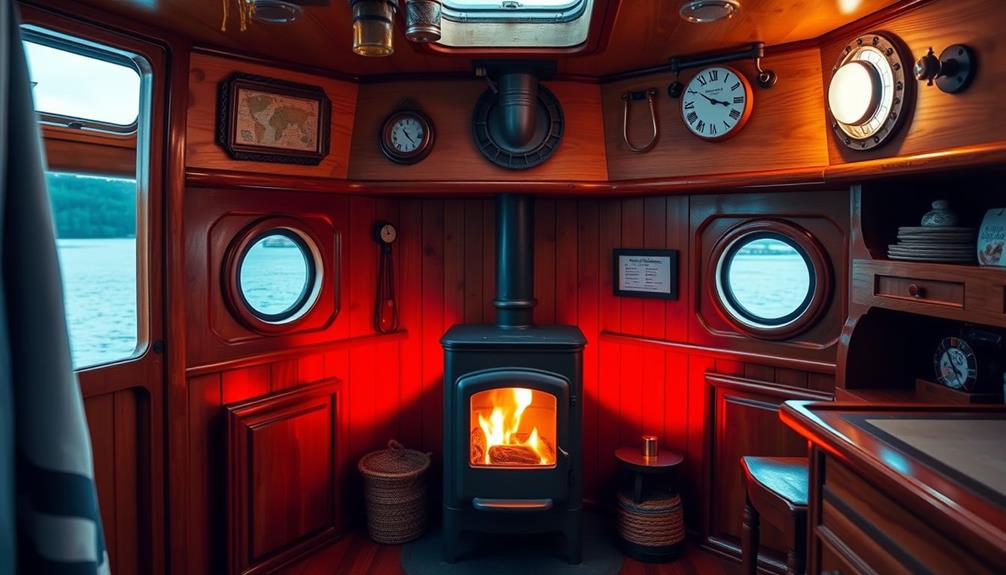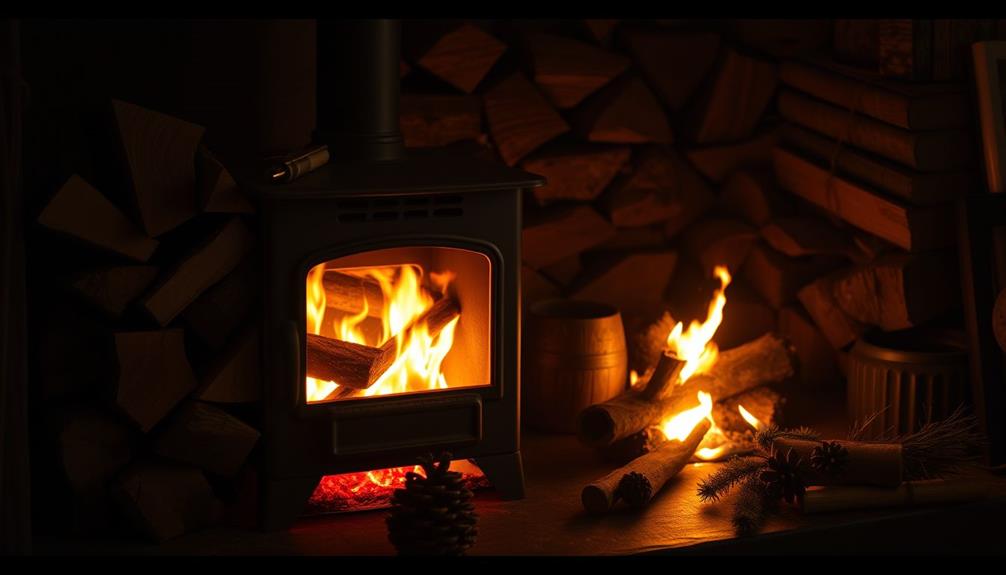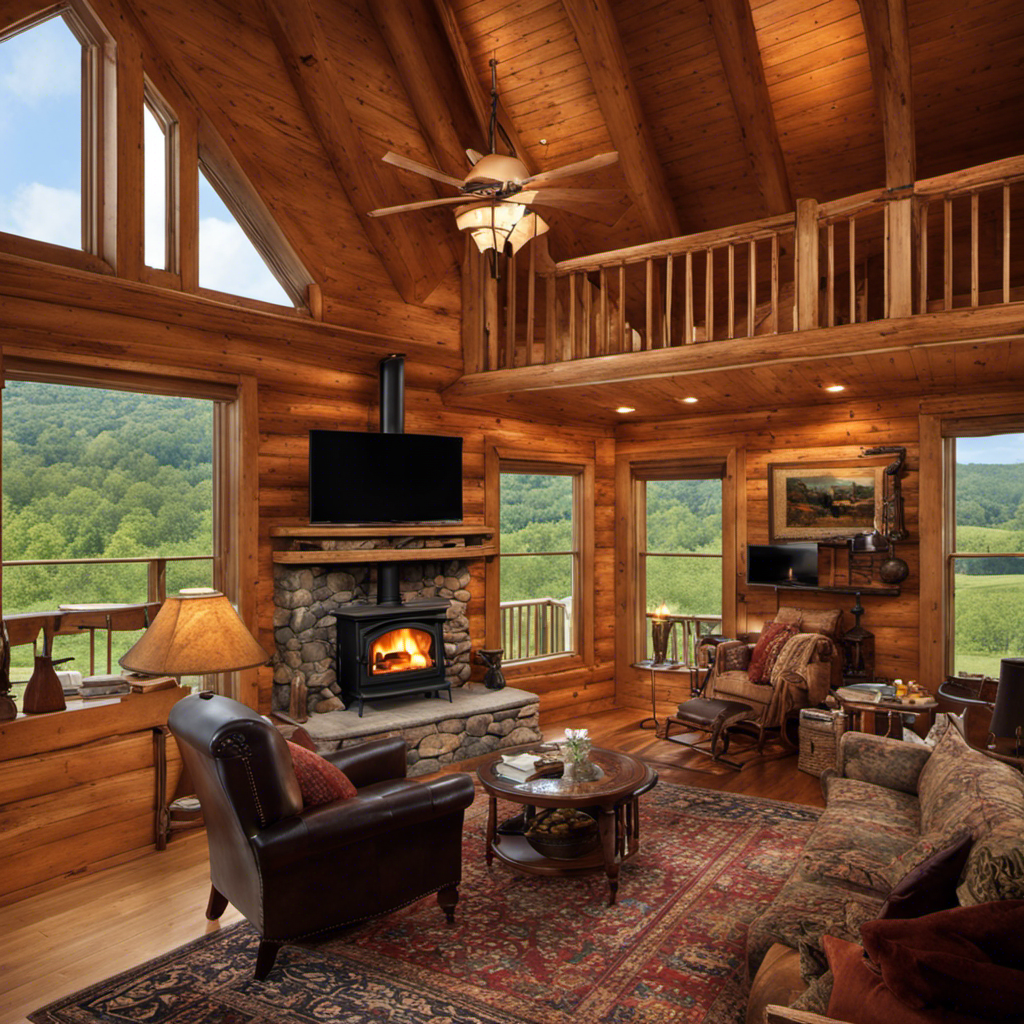If you're considering small wood stoves for your boat or RV, you'll need to pay attention to installation, safety regulations, and proper maintenance. Make certain to maintain safety clearances and comply with local codes to prevent fire hazards. Use seasoned wood for efficient burning and keep your stove clean to guarantee good airflow. Regularly clean the chimney and flue to avoid dangerous buildup. Remember, models can provide over 70% efficiency, but proper setup is essential. For more insights on best practices and user experiences, there's plenty more to uncover about optimizing your heating solution.
Key Takeaways
- Ensure compliance with local regulations and safety standards for safe installation and to avoid insurance issues.
- Maintain proper clearances from walls and combustibles to prevent fire hazards during operation.
- Use seasoned wood for efficient burning, producing more heat and reducing emissions for optimal performance.
- Regular maintenance, including ash removal and chimney cleaning, is essential for safe and efficient stove operation.
- Consider alternative heating options like diesel or propane systems if daily wood management is a concern.
Installation Considerations
When installing a wood stove in your RV or small trailer, you'll need to pay close attention to safety clearances. Specific regulations dictate how far your small wood stove must be from walls and other combustibles. Failing to maintain these proper clearances can lead to dangerous situations.
Additionally, it's important to guarantee compliance with safety standards related to heating appliances to avoid any potential hazards.
You'll also need to take into account significant modifications for installation, like creating a large hole for the stovepipe. This can complicate the setup process, so be prepared for some DIY work or consider hiring a professional to guarantee everything's done safely.
Don't forget about the costs; you'll likely need stovepipes, fittings, and heat shields, which can add up quickly.
Proper venting is essential for your wood stove's performance. Aim for a minimum vertical flue height of 15 inches to guarantee adequate draft and prevent smoke issues inside your RV or trailer.
Before you begin, check local regulations, as some areas have bans or restrictions on wood-burning appliances. This will help you avoid any compliance issues down the line.
Taking these installation considerations into account won't only keep you safe but also guarantee your wood stove operates effectively.
Fuel Requirements
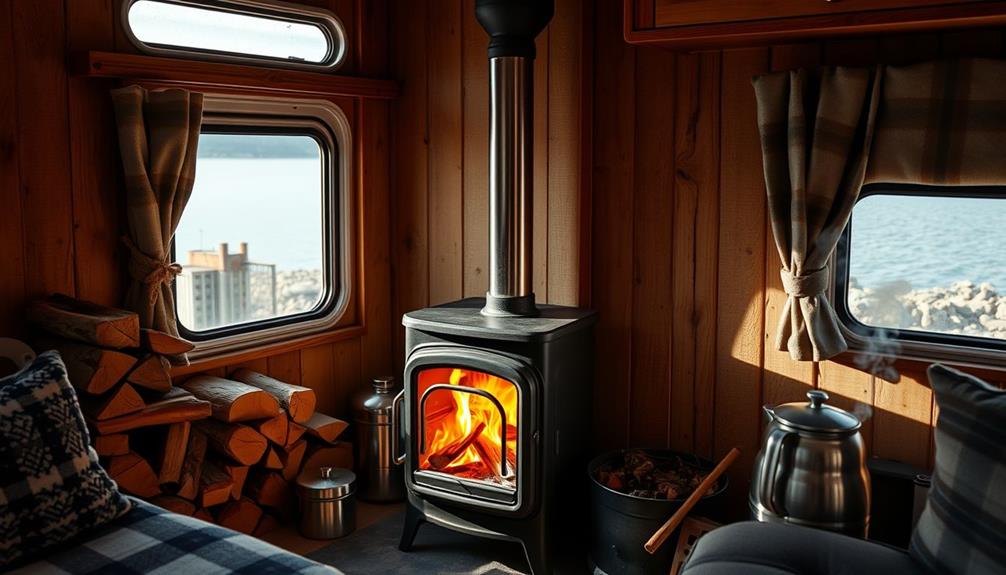
To guarantee your small wood stove operates efficiently, you'll need to pay close attention to fuel requirements. First and foremost, use seasoned wood for burning; it produces more heat and fewer emissions compared to wet wood. Wet wood can hinder combustion and is often restricted by local bans, so it's important to avoid it.
Additionally, verifying your stove is free of any obstructions will promote better airflow, similar to how positive reinforcement methods yield the best training results for dogs.
Make sure to cut your wood into small pieces. Larger logs can obstruct airflow and reduce heat output, making your small wood burning stove less effective. If you're in a region where unprocessed wood can't be transported, consider sourcing your fuel locally or opting for kiln-dried lumber. Pressed logs are another excellent option, as they can be conveniently cut into chunks that fit well in your stove.
Daily management of your fuel supply is vital. You'll need to regularly replenish and prepare your wood to maintain adequate heat levels throughout the day.
Maintenance and Cleaning
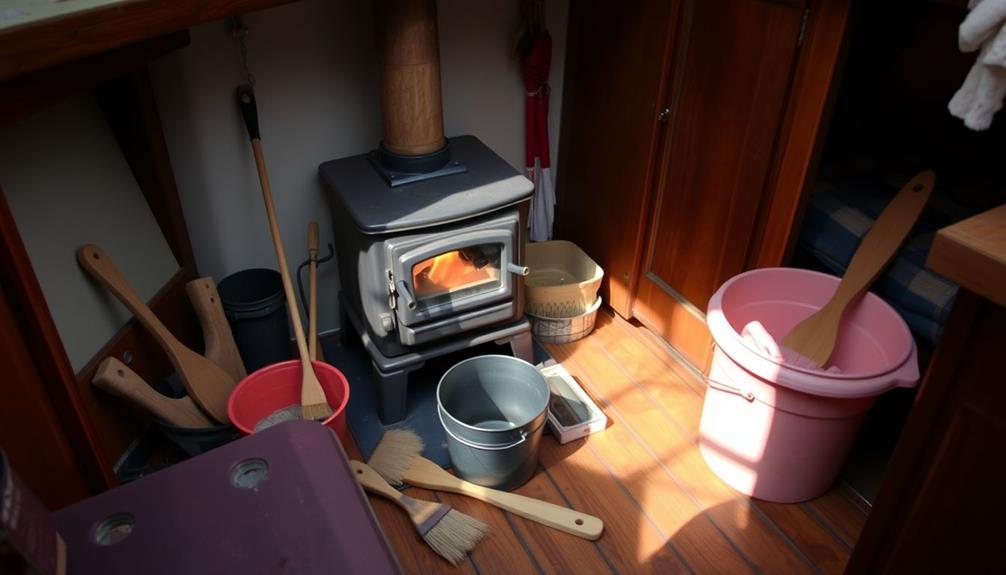
Keeping your small wood stove clean is essential for ideal performance and safety. Regular maintenance not only enhances efficiency but also contributes to better indoor air quality, similar to how air purifiers improve indoor air quality.
You should establish a daily cleaning routine to manage ash and residue effectively, ensuring proper airflow and reducing fire hazards.
Let's explore some practical ash management strategies to simplify your maintenance efforts.
Daily Cleaning Routine
Maintaining a clean wood stove is essential for its performance and safety, especially in the confined spaces of boats and RVs.
Daily cleaning helps manage the mess created by ash and residue buildup, ensuring your wood burning stove operates efficiently. Start by removing ashes when the stove is cool; this prevents blockages and promotes proper airflow.
Additionally, consider using a professional cleaning service for more intensive maintenance tasks that may arise over time.
Next, make it a habit to clean the glass door regularly. Soot and creosote can accumulate, obstructing visibility and reducing your stove's efficiency. A clear view not only enhances your experience but also helps you keep an eye on the fire.
Don't forget to inspect and clean the chimney and flue system periodically. This step is vital for maintaining proper venting of smoke and gases, safeguarding your living space from dangerous blockages.
Ash Management Strategies
Regular ash removal is a key part of your wood stove maintenance routine. Since wood stoves generate a significant amount of ash, daily cleaning is crucial to maintain efficiency and prevent flue clogs. Use a dedicated ash container made of metal for safe disposal, guaranteeing it's properly sealed to prevent fires. Always allow ashes to cool completely before disposal; hot ashes can pose a serious fire hazard if placed in combustible materials.
For effective ash management, consider the following strategies:
| Strategy | Description |
|---|---|
| Daily Ash Removal | Remove ashes every day to maintain efficiency. |
| Use an Ash Container | Confirm it's metal and sealed to prevent fires. |
| Employ an Ash Vacuum | Simplify cleanup and minimize mess. |
Cleaning the surrounding area of the stove is also necessary to manage soot and debris. An ash vacuum specifically designed for wood stoves can greatly simplify cleanup, making it easier to manage ash without creating additional mess. By implementing these ash management strategies, you'll keep your wood stove operating smoothly and your living space tidy.
Heating Efficiency
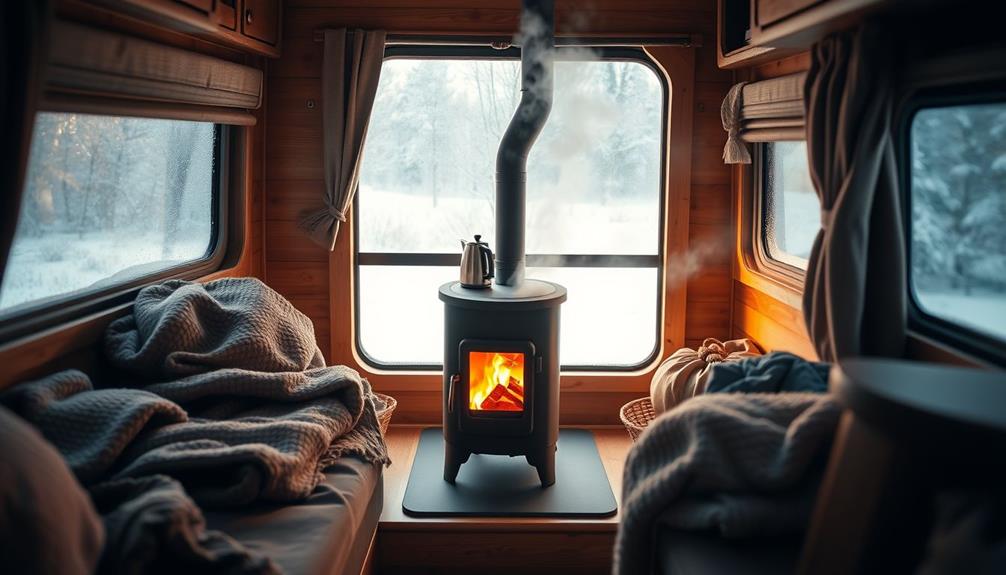
When it comes to heating small spaces like boats and RVs, efficiency is key. You want a stove that not only provides warmth but does so effectively. Small wood stoves, like the Kimberly™ and Dwarf models, excel in this area, often boasting efficiency ratings over 70%.
For instance, the BTU rating of the Englander 10-Cpm showcases how it generates up to 50,000 BTUs, making it suitable for larger spaces as well. This means you can rely on them for effective heating, even in extreme cold.
- Enjoy prolonged warmth with impressive burn times of 6-8 hours.
- Benefit from dry heat that reduces condensation issues.
- Optimize your wood heat with seasoned wood or pressed logs.
To maximize heating efficiency, proper installation is essential. Make sure there's adequate clearance and venting to prevent smoke issues in tight spaces.
Remember, burning wet wood markedly decreases efficiency and can lead to air quality problems. By choosing the right stove and maintaining it well, you'll enjoy reliable heat while minimizing your environmental impact.
Embrace the cozy atmosphere that efficient wood heat provides, and make your adventures in boats and RVs more comfortable than ever!
Safety and Compliance
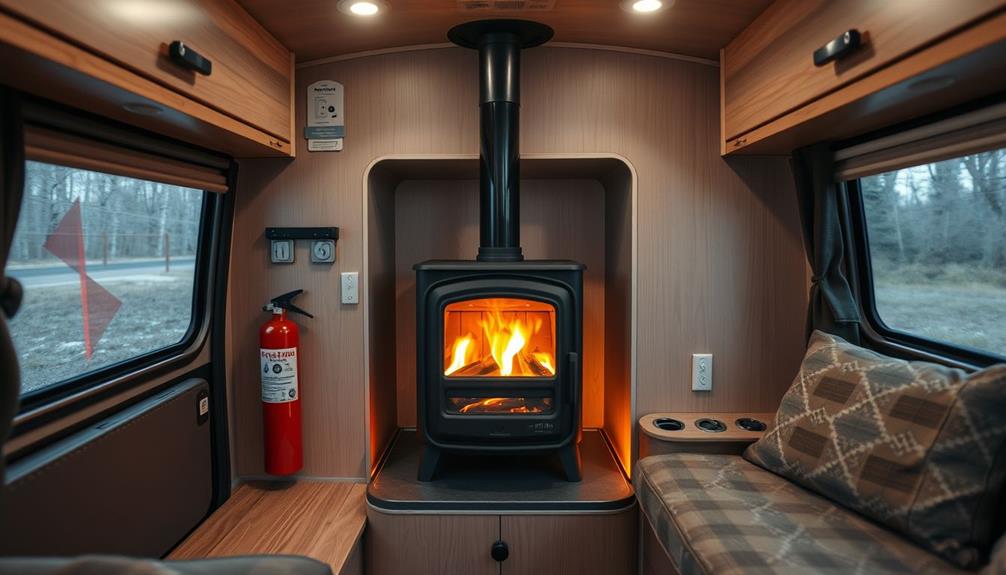
When installing a wood stove in your boat or RV, you need to pay close attention to local regulations and codes to guarantee safety.
Understanding the potential emotional challenges of living with a wood stove can also help you make informed decisions about your setup.
Failing to comply can't only create fire hazards but may also jeopardize your insurance coverage.
Always check the installation requirements and clearances to protect yourself and your property.
Installation Regulations and Codes
Guaranteeing compliance with local fire regulations is vital for the safe installation of wood stoves in boats and RVs. Proper adherence to installation codes is essential to avoid dangerous situations like fires and carbon monoxide risks.
Here are some key points to take into account:
- Many regions have specific installation codes that dictate venting requirements and clearances for woodburning stoves, similar to the regulations surrounding Gold IRA scams which emphasize the importance of legitimacy and compliance.
- Stoves must be securely anchored to the superstructure of your RV or boat to prevent tipping during travel.
- If you're in a smoke-controlled zone, verify your stove meets the smoke exempt criteria.
Consulting professionals for installation is a smart move. They'll help you comply with safety standards, guaranteeing proper flue height and effective ventilation systems to prevent smoke and gas buildup.
Remember, improper installations not only jeopardize safety but can also void your insurance. Verify local regulations regarding the transportation and burning of wood, particularly to prevent pest spread.
Insurance and Liability Concerns
Installing a wood stove in your RV or boat can provide cozy warmth, but it comes with important insurance and liability concerns you can't afford to overlook. Compliance with local fire regulations is vital; failing to adhere can void your insurance policy and expose you to significant financial risks.
Many insurance companies may refuse coverage for RVs equipped with wood stoves due to the increased fire hazards, leading to potential liability issues for you as the owner. Additionally, consider the implications of your investment choices and how they relate to your overall financial goals, similar to the benefits of converting 401k to Gold IRA.
Furthermore, incorrect installation can result in dangerous situations like fires or carbon monoxide poisoning, making it essential to follow safety guidelines and local codes meticulously. Local regulations might even restrict the transportation of wood to prevent pest spread, complicating your wood stove usage and affecting compliance with insurance requirements.
Don't forget that misrepresenting the presence of a wood stove on your insurance applications can void your coverage entirely. Transparency is critical, so make sure you disclose all necessary information and adhere to safety standards.
User Experiences
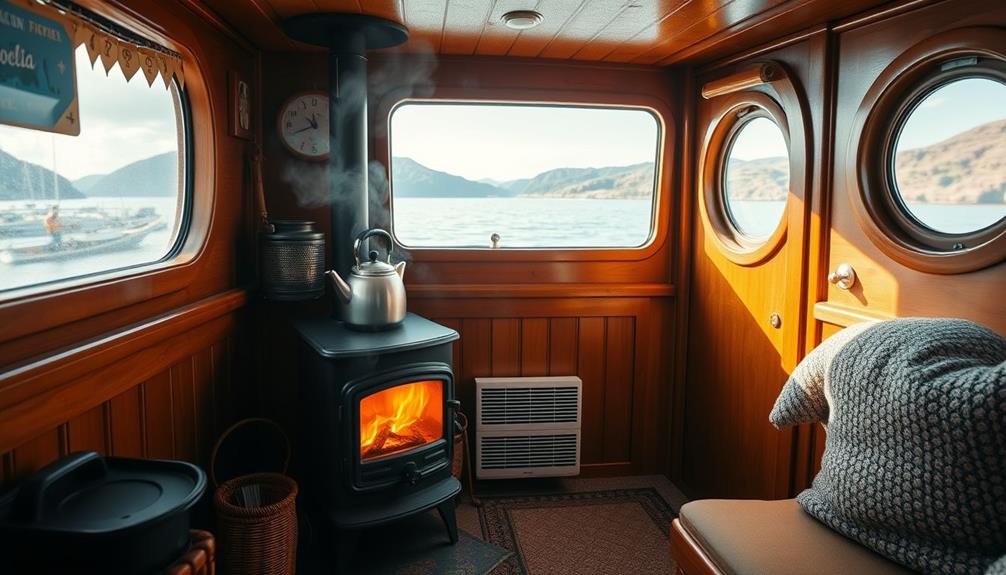
For many RVers and boaters, the allure of a small wood stove often comes with a mix of joy and frustration. While the warmth and ambiance of a crackling fire can create a cozy atmosphere, many users report that daily maintenance can be tiresome.
The community around wood stoves is vibrant, with plenty of shared experiences, but there are also cautionary tales to reflect upon. Additionally, the reliance on renewable energy sources, such as geothermal energy, can complement the use of wood stoves by providing an eco-friendly heating option.
- Users in cold climates, like Vermont, find models like the Dwarf 5kW provide reliable heat.
- Smaller stoves are often favored for efficiency in tight spaces.
- Proper installation and adherence to safety regulations are essential for peak performance.
Some RV owners cherish the nostalgic charm of wood heat, while others lean towards the convenience of diesel or propane options.
It's clear that installing a wood stove requires commitment. Users emphasize the importance of securing stoves and maintaining proper flue height to guarantee safety.
Engaging with the community can help you navigate the challenges and joys of using a small wood stove, allowing you to make the most of your adventures on the road or water.
Alternatives to Wood Stoves

When considering heating options for your RV or boat, you'll find several viable alternatives to wood stoves that cater to different needs and preferences.
Diesel heaters stand out for their consistent and low-maintenance heating, making them an attractive option for travelers who value convenience. You won't have to worry about daily fuel management, making them a hassle-free choice.
Additionally, garage door openers can enhance your security while you're away, guaranteeing peace of mind.
Propane heating systems are another practical option, especially in small spaces. They provide efficient warmth without the mess and upkeep that come with wood-fired appliances.
If you're looking for something with longer burn times and higher heat output, coal stoves can work as alternatives to wood stoves, although they may involve more complex installation and ventilation requirements.
Electric heaters are perfect if you have reliable power sources available. They offer ease of use and minimal installation compared to wood stoves.
You might also consider specialized options like ceramic or infrared heaters. These can efficiently warm small spaces and operate without the need for venting or chimney installations, making them user-friendly and convenient.
Whatever your choice, verify it aligns with your heating needs and living space.
Frequently Asked Questions
Can You Put a Small Wood Stove in an Rv?
Yes, you can put a small wood stove in your RV, but you'll need to take into account installation clearances, ventilation, and local fire regulations to guarantee safety and efficiency while managing fuel and maintenance effectively.
Can You Put a Wood Burning Stove on a Boat?
When it comes to putting a wood-burning stove on your boat, it's a balancing act. You can do it, but you've gotta follow safety regulations, guarantee proper venting, and keep fire hazards in check.
Can You Have a Wood Burning Fireplace in an Rv?
You can install a wood-burning fireplace in an RV, but you'll need to follow specific regulations and safety codes. Consider the modifications required, maintenance needs, and potential insurance implications before making your decision.
What Size Wood Stove for Rv?
When choosing a wood stove for your RV, consider its dimensions, heating needs, and burn time. A 3kW model fits smaller spaces, while a 5kW stove suits colder climates, ensuring warmth and comfort during your travels.
Conclusion
To sum up, while you might worry about the hassle of installing a small wood stove on your boat or RV, the cozy warmth and efficiency it provides can make the effort worthwhile. Don't let concerns about maintenance hold you back; with regular care, these stoves can last for years, enhancing your adventures. Plus, nothing beats the charm of a wood fire. Embrace the comfort and enjoy the unique experience a wood stove offers on the water or the road!

